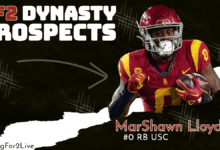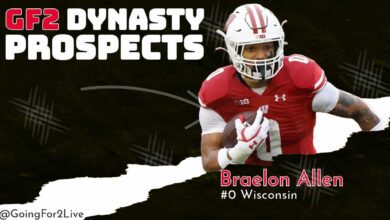
It’s never too early to talk fantasy football, in fact now is a great time to start talking about it. Why you ask? Because 90 percent of your league mates aren’t talking about it. Advantage — you.
Football is a unique beast when it comes to fantasy. Rarely in other sports do you have the “came out of nowhere” player that can win your league. When is the last time you said, “Man, I’m glad I got the Milwaukee Bucks’ third-string point guard off the waiver wire. He helped me win a championship.”. I guarantee those words have never been uttered in fantasy basketball, but how many of you won your football championship because you added DeVonta Freeman mid-season last year?
Fantasy football is more about finding that diamond in the rough — that rare player that somehow gets overlooked, and then when given the opportunity, explodes. Winning a fantasy football championship isn’t won on draft day, but if not done right, it can be lost.
I myself have won multiple fantasy championships through careful pre-draft research, even when the research was harder to come by than it is today. Over the years, I’ve created an unofficial list of Dos and Don’ts, and now that I’m in a position to share that unofficial list I’m going to make it official.

(these rules are for standard sized 10-12 team leagues)
The Official Fantasy Football Draft Dos and Don’ts
Do: Know your league’s scoring system
This is the most basic rule there is — and the most important. Everything I write after this will mean nothing if you don’t do this. Is your league a PPR league? Do you get four points for a passing touchdown, or six? Are bonus points awarded for milestones, i.e. 100 yards rushing? Did your commissioner change anything from the previous year, no matter how small that change may be?
If you can’t answer these type of questions regarding your scoring system, then give me your email and I’ll send you an invite to my league. I would love to take your money.
Don’t: Draft a kicker or defense before the last two rounds
This is a two-part rule, and we’ll start with defense.
The No. 1 drafted defense last year, according to ADP (average draft position), was the Seattle Seahawks. They finished a modest 11th overall — which isn’t too bad — but when you consider the Steelers defense went largely undrafted as the 18th defense off the board, yet they finished four spots ahead of the Seahawks, taking the Seahawks so early isn’t worth it. To put that in perspective, the Seahawks were drafted with an ADP of 64 but you could have had Larry Fitzgerald at 68 and still draft the Steelers defense in the second to last round.
Now we’ll get to the kicker position. The difference between the No. 1 kicker and the No. 10 kicker last year was 31 points. Extrapolate that over a 16 game fantasy season and you have gained yourself 1.9 extra points per game by drafting Stephen Gostkowski with the 95th overall pick. So you passed on David Johnson at 118. Congratulations.
Some of these Dos and Don’ts have exceptions to the rule. This one does not. Never draft a kicker or defense before the last two rounds. As a matter of fact, if your draft is before the start of preseason, don’t even draft a kicker or defense at all. Grab two potential breakout players, hold on to them through the preseason and see if they pan out. You can always drop two guys to pick up your defense and kicker before the season starts.
If somehow all your “sleepers” become preseason MVPs, you can always package two of them for a stud player from an overhyped owner, leaving yourself with an open spot to add your kicker or defense and wind up with a stud in return. I mean, how many preseason MVPs really pan out in the regular season anyway? Which brings me to my next rule…
Love our content? Check out the GoingFor2 Live Podcast Network!
Don’t: Get caught up in preseason hype
It happens every year, be it a rookie or an unknown veteran, but there is always at least one or two guys that will have a phenomenal preseason and get hyped as “the next big thing”. Don’t fall for it. There are those few that can carry that success into the regular season, so I’m not saying to completely ignore them, just temper your excitement. I would limit myself to one, maybe two preseason hype, came-out-of-nowhere, next-big-thing type players.
Just to make my point a little stronger, here are a few of last year’s preseason hype machines: Ameer Abdullah, T.J. Yeldon, and Andre Johnson (new team). None of those three turned out to be worth much at all except waiver wire fodder. Johnson holds a special place in my book of bad calls. I hyped him up the entire offseason and thought he would be amazing with Andrew Luck as his QB. Not so much.
Do: Wait on a QB
This rule has a few exceptions, namely Aaron Rodgers and Cam Newton for 2016. Looking at last year, if we take out the three QBs that went over 400 fantasy points (Cam Newton, Tom Brady, Russell Wilson) the difference between the fourth QB (Carson Palmer) and the 13th QB (Derek Carr) was a tad over 3 points per game.
What does this mean exactly? It means you can wait on a quarterback and still get one that will be just as good as the one going in the mid-rounds. Use those mid-round picks for your wide receivers and running backs.
Don’t: Draft more than one quarterback, tight end, kicker, or defense
There are obvious exceptions to this rule, but the two that immediately come to mind are: 1) your league has an OP slot in which you can start two quarterbacks, or, 2) you’re drafting an injury prone starter and want that extra insurance. I’m not going to spend a lot of time explaining why you shouldn’t draft two kickers or defenses, just take my word and don’t do it. There will be plenty of bye week fill-ins for the one game you’ll need them, and kickers aren’t exactly injury risks. I will, however, explain the other two.
We’ll start with tight ends because it’s easier. The tight end position is very top heavy. As far as “studs” go, you might have four or five tight ends that could carry that “stud” title in a given year. In 2015, there were only four tight ends that over 200 fantasy points (PPR), Rob Gronkowski, Jordan Reed, Greg Olsen, and Gary Barnidge. So unless you are drafting two of these guys, it’s not worth wasting a draft pick on a second tight end. After the top four or five tight ends, they become J.A.G. (Just Another Guy).
Most leagues have at least two running back slots and two or three wide receiver slots, so that’s potentially five bye weeks you’re going to have to cover during the season. By drafting two tight ends, you’re giving up a wide receiver or running back that can cover all those bye weeks — and be productive as well, scoring more than 10 points per game. Instead, you’ll have an extra tight end that will cover one bye week and won’t score much more than tight ends on the waiver wire. Unless you’re drafting Jordan Reed and Rob Gronkowski, and your league format allows you to start both, please don’t draft two tight ends.
Now let’s tackle the quarterback (pun intended). Not having a backup quarterback gets a lot of people nervous — I used to be one of those people — until one year when I lost both my quarterbacks. Now, you might be thinking this unfortunate incident would be the reason for drafting two quarterbacks, not against it, but hear me out.
I lost my second quarterback just past the midway point of the fantasy season, so about Week 7. That meant six weeks of regular season games and potentially three weeks of playoffs. For the next nine weeks — and yes I made it to the championship game — I was streaming quarterbacks. Each week, I would look at matchups, find a quarterback on the waiver wire I felt would have a decent game, and plug him into my lineup. Surprisingly, week in and week out I found one that ended up being a viable starter. I’m not advocating that streaming quarterbacks is always a good idea, but what it made me realize is that every week there is at least one viable QB on the waiver wire.
Applying this realization to drafting quarterbacks, I came to the conclusion that owning a backup quarterback to fill in for one bye week, and keeping him on my roster to do nothing for the other 15 games, was a complete waste of a roster spot. I could just pick up a quarterback off waivers for that one week, and save that roster spot for another wide receiver or running back that is way more valuable covering bye weeks.
The only time I will advocate having a second quarterback would be if there is a starting-caliber quarterback sitting on the waiver wire a week or so before your trade deadline. If that happens, then I would recommend adding him to your roster, but by no means does that mean you should draft a second quarterback. There is too much value to be had in those late rounds that a second quarterback just isn’t worth it.
This concludes Part 1 of my fantasy Dos and Don’ts. Be sure to check back for Part 2, and please subscribe to our mailing list below to have all our content sent to you inbox…
[wysija_form id=”1″]ATTN Dynasty Commissioners: Do you want to do something cool for your league? How about a 1-hour live show dedicated to YOUR league? Team-by-team breakdowns, rankings, and more. For details and to book a show, visit: GoingFor2.com/plp.





